Spray Angle and Uniformity of the Flat Fan Nozzle of Deep Loosener Fertilizer for Intra-Soil Application of Fertilizers
Abstract
:1. Introduction
2. Materials and Methods
2.1. Nozzle Design
2.2. Theoretical Analyses
2.3. Computational Analyzes
2.3.1. CFD Study of a Flat Atomizer with a Semicircular Impact Surface
2.3.2. Dividing the Output Surface into Several Equal Parts
2.3.3. Optimization of the Flat Sprayer Parameters
2.4. Laboratory Experiments
2.4.1. Experimental Setup
2.4.2. Spray Uniformity Evaluation
2.4.3. The Spray Uniformity Evaluation by Wetting (Absorption) Shape and Dimensions
3. Results and Discussions
3.1. The Sprayer Orifice Shape Search, and Results of the Optimization Calculations
3.2. Results of the Experiments
3.2.1. Experimental Results for Checking the Parameters of the d > d1 Sprayer Type
3.2.2. Absorption Form, Degree of Soil Moisture, and Spray Uniformity
3.3. Field Experiments and Future Studies
4. Conclusions
Author Contributions
Funding
Data Availability Statement
Acknowledgments
Conflicts of Interest
Appendix A
| s | d1/2 | L4 | Ltr (Graphical) | Ltr with Equation (27) | Ltr with Equation (11) | Lo | The Angle Limits |
|---|---|---|---|---|---|---|---|
| 0.4 | |||||||
| 0.5 | 1.007 | 2.498092 | 2.44633808 | 2.412256 | 7.286101667 | 145–167 | |
| 0.6 | 1.212 | 2.760629 | 2.730054005 | 2.7033 | 8.051834583 | flat angle | |
| 0.7 | 1.419 | 3.050659 | 3.029897048 | 2.99806 | 8.897755417 | flat angle | |
| 0.8 | 1.629 | 3.351032 | 3.335850878 | 3.296536 | 9.773843333 | flat angle | |
| 0.9 | 1.841 | 3.656431 | 3.644785371 | 3.598728 | 10.66459042 | flat angle | |
| 0.3 | |||||||
| 0.5 | 1.007 | 2.214297 | 2.196760752 | 2.166754 | 6.45836625 | 126–148 | |
| 0.6 | 1.212 | 2.513274 | 2.501888159 | 2.463234 | 7.3303825 | 147–168 | |
| 0.7 | 1.419 | 2.81919 | 2.81113048 | 2.76343 | 8.2226375 | flat angle | |
| 0.8 | 1.629 | 3.128309 | 3.122278315 | 3.067342 | 9.124234583 | flat angle | |
| 0.9 | 1.841 | 3.43914 | 3.434447087 | 3.37497 | 10.030825 | flat angle | |
| 0.2 | |||||||
| 0.5 | 1.007 | 1.982313 | 1.977691757 | 1.934244 | 5.78174625 | 113–132 | |
| 0.6 | 1.212 | 2.29276 | 2.289631391 | 2.23616 | 6.687216667 | 135–153 | |
| 0.7 | 1.419 | 2.604767 | 2.602502722 | 2.541792 | 7.597237083 | 161–174 | |
| 0.8 | 1.629 | 2.917563 | 2.915845112 | 2.85114 | 8.50955875 | flat angle | |
| 0.9 | 1.841 | 3.230801 | 3.229452658 | 3.164204 | 9.423169583 | flat angle | |
| 0.1 | |||||||
| 0.5 | 1.007 | 1.772154 | 1.771610666 | 1.714726 | 5.1687825 | 100–118 | |
| 0.6 | 1.212 | 2.085893 | 2.085518012 | 2.022078 | 6.083854583 | 122–139 | |
| 0.7 | 1.419 | 2.399801 | 2.085518012 | 2.333146 | 6.999419583 | 147–160 | |
| 0.8 | 1.629 | 2.713799 | 2.713588779 | 2.64793 | 7.915247083 | 173–180 | |
| 0.9 | 1.841 | 3.027847 | 3.027681645 | 2.96643 | 8.831220417 | flat angle | |
| 0 | |||||||
| 0.5 | 1.007 | 1.570796 | 1.570796327 | 1.5082 | 4.581488333 | 88–105 | |
| 0.6 | 1.212 | 1.884956 | 1.884955592 | 1.820988 | 5.497788333 | 110–126 | |
| 0.7 | 1.419 | 2.199115 | 2.199115 | 2.137492 | 6.414085417 | 134–147 | |
| 0.8 | 1.629 | 2.513274 | 2.513274 | 2.457712 | 7.3303825 | 162–168 | |
| 0.9 | 1.841 | 2.827433 | 2.827433388 | 2.781648 | 8.246679583 | flat angle |
| ID | Parameter Name | Symbols | Value | Unit |
|---|---|---|---|---|
| 1 | 2 | 3 | 4 | 5 |
| Input Parameters | ||||
| Geometry (A1) | ||||
| P1 | Extrude2.FD1 | K | 5 | mm |
| P2 | Extrude4.FD1 | H | 0.7 | mm |
| P3 | ZXPlane.R5 | R (d1) | 1 | mm |
| P74 | Plane4.R16 | rd (Ds/2) | 4 | mm |
| P148 | XYPlane.R2 | d/2 | 1 | mm |
| Fluent (with Fluent Meshing) (B1) | ||||
| P154 | velocity | Vi | 6000 | mm s−1 |
| Output Parameters | ||||
| Fluent (with Fluent Meshing) (B1) | Value | Unit | ||
| P156 | out-vfr-7-op | Q7 | −779.19213 | mm3 s−1 |
| P157 | out-vfr-8-op | Q8 | −746.50933 | mm3 s−1 |
| P158 | out-vfr-10-op | Q10 | −747.07094 | mm3 s−1 |
| P159 | out-vfr-12-op | Q712 | −687.25524 | mm3 s−1 |
| P160 | out-vfr-21-op | Q21 | −623.98351 | mm3 s−1 |
| P161 | out-vfr-24-op | Q24 | −659.62593 | mm3 s−1 |
| P162 | out-vfr-25-op | Q25 | −729.6332 | mm3 s−1 |
| P163 | out-vfr-26-op | Q26 | −601.17009 | mm3 s−1 |
| P164 | out-vfr-28-op | Q28 | −156.66363 | mm3 s−1 |
| P165 | out-vfr-29-op | Q29 | −273.94256 | mm3 s−1 |
| P166 | out-vfr-30-op | Q30 | −1392.3157 | mm3 s−1 |
| P169 | out-vfr-1-op | Q1 | −416.8453 | mm3 s−1 |
| P170 | out-vfr-2-op | Q2 | −219.89692 | mm3 s−1 |
| P171 | out-vfr-3-op | Q3 | −443.29693 | mm3 s−1 |
| P172 | out-vfr-4-op | Q4 | −665.22239 | mm3 s−1 |
| P173 | out-vfr-5-op | Q5 | −789.99409 | mm3 s−1 |
| P174 | out-vfr-6-op | Q6 | −816.03901 | mm3 s−1 |
| P175 | out-vfr-9-op | Q9 | −747.40171 | mm3 s−1 |
| P176 | out-vfr-11-op | Q11 | −719.43089 | mm3 s−1 |
| P177 | out-vfr-13-op | Q13 | −681.33977 | mm3 s−1 |
| P178 | out-vfr-14-op | Q14 | −668.4121 | mm3 s−1 |
| P179 | out-vfr-15-op | Q15 | −646.98662 | mm3 s−1 |
| P180 | out-vfr-16-op | Q16 | −626.79214 | mm3 s−1 |
| P181 | out-vfr-17-op | Q17 | −625.36054 | mm3 s−1 |
| P182 | out-vfr-18-op | Q18 | −628.43384 | mm3 s−1 |
| P183 | out-vfr-19-op | Q19 | −626.88525 | mm3 s−1 |
| P184 | out-vfr-20-op | Q20 | −627.1045 | mm3 s−1 |
| P185 | out-vfr-22-op | Q22 | −605.09348 | mm3 s−1 |
| P186 | out-vfr-23-op | Q23 | −607.52501 | mm3 s−1 |
| P187 | out-vfr-27-op | Q27 | −314.46172 | mm3 s−1 |
| P196 | back-flux1-op | P | 0 | MPa |
| P197 | back-flux2-op | P | −0.009623637 | MPa |
| P228 | inlet-area-op | Ai | 3.128594 | mm2 |
| P230 | inl-vfr-op | Qi | 18771.563 | mm3 s−1 |
| P231 | inl-vfr-/28-constant-op | Qwcons | 670.41299 | mm3 s−1 |
| P232 | sum-28-vfr-op | −17064.724 | mm3 s−1 | |
| . w = 28 | ||||
| P233 | inl-/-28-ratio-vfr-op | −1.1000215 | ||
| P262 | out-full-veloc-ave-op | Voavg | 3935.0078 | mm s−1 |
| P263 | out-vfr-full-op | Qo | −18873.885 | mm3 s−1 |
| P264 | area-wei-ave-veloc-out-op | VAwaV | 3667.1295 | mm s−1 |
| P265 | sd-sum-28-op | −609.45439 | mm3 s−1 | |
| P267 | max-velo-out-op | Vomax | 10559.475 | mm s−1 |
| P268 | cons-ratio-op | −0.90907305 | ||
| P269 | cret-1-op (S28) | 1.2100474 | ||
| P150 | Output Area | Ao | 8.79645943 | mm2 |
| P151 | trans Area | Atr | 2.199114858 | mm2 |
| P152 | Inl Out ratio | Ao/Ai | 2.811633414 | |
| P153 | Trans Inl ratio | Atr/Ai | 0.898689128 | |
| P155 | Sel 30 Area | Aw | 0.293215314 | mm2 |
| P198 | Ratio1 | Q1/Qwcons | −0.621773901 | |
| P199 | Ratio 2 | Q2/Qwcons | −0.328002177 | |
| P200 | Ratio 3 | Q3/Qwcons | −0.661229625 | |
| P201 | Ratio 4 | Q4/Qwcons | −0.992257608 | |
| P202 | Ratio 5 | Q5/Qwcons | −1.178369306 | |
| P203 | Ratio 6 | Q6/Qwcons | −1.217218375 | |
| P204 | Ratio 7 | Q7/Qwcons | −1.16225691 | |
| P205 | Ratio 8 | Q8/Qwcons | −1.113506661 | |
| P206 | Ratio 9 | Q9/Qwcons | −1.114837751 | |
| P207 | Ratio 10 | Q10/Qwcons | −1.114344369 | |
| P208 | Ratio 11 | Q11/Qwcons | −1.073115976 | |
| P209 | Ratio 12 | Q12/Qwcons | −1.025122201 | |
| P210 | Ratio 13 | Q13/Qwcons | −1.01629858 | |
| P211 | Ratio 14 | Q14/Qwcons | −0.997015437 | |
| P212 | Ratio 15 | Q15/Qwcons | −0.965056808 | |
| P213 | Ration16 | Q16/Qwcons | −0.93493436 | |
| P214 | Ratio 17 | Q17/Qwcons | −0.93279896 | |
| P215 | Ratio 18 | Q18/Qwcons | −0.937383149 | |
| P216 | Ratio 19 | Q19/Qwcons | −0.935073245 | |
| P217 | Ratio 20 | Q20/Qwcons | −0.935400282 | |
| P218 | Ratio 21 | Q21/Qwcons | −0.930744958 | |
| P219 | Ratio 22 | Q22/Qwcons | −0.902568251 | |
| P220 | Ratio 23 | Q23/Qwcons | −0.906195165 | |
| P221 | Ratio 24 | Q24/Qwcons | −0.983909828 | |
| P222 | Ratio 25 | Q25/Qwcons | −1.088333924 | |
| P223 | Ratio 26 | Q26/Qwcons | −0.896716053 | |
| P224 | Ratio 27 | Q27/Qwcons | −0.469056723 | |
| P225 | Ratio 28 | Q28/Qwcons | −0.233682271 | |
| P226 | Ratio 29 | Q29/Qwcons | −0.408617619 | |
| P227 | Ratio 30 | Q30/Qwcons | −2.076802987 | |
| P234 | w2 | −219.89692 | mm3 s−1 | |
| P235 | w3 | −443.29693 | mm3 s−1 | |
| P236 | w4 | −665.22239 | mm3 s−1 | |
| P237 | w5 | −789.99409 | mm3 s−1 | |
| P238 | w6 | −816.03901 | mm3 s−1 | |
| P239 | w7 | −779.19213 | mm3 s−1 | |
| P240 | w8 | −746.50933 | mm3 s−1 | |
| P241 | w9 | −747.40171 | mm3 s−1 | |
| P242 | w10 | −747.07094 | mm3 s−1 | |
| P243 | w11 | −719.43089 | mm3 s−1 | |
| P244 | w12 | −687.25524 | mm3 s−1 | |
| P245 | w13 | −816.03901 | mm3 s−1 | |
| P246 | w14 | −668.4121 | mm3 s−1 | |
| P247 | w15 | −646.98662 | mm3 s−1 | |
| P248 | w16 | −626.79214 | mm3 s−1 | |
| P249 | w17 | −625.36054 | mm3 s−1 | |
| P250 | w18 | −628.43384 | mm3 s−1 | |
| P251 | w19 | −626.88525 | mm3 s−1 | |
| P252 | w20 | −627.1045 | mm3 s−1 | |
| P253 | w21 | −623.98351 | mm3 s−1 | |
| P254 | w22 | −605.09348 | mm3 s−1 | |
| P255 | w23 | −607.52501 | mm3 s−1 | |
| P256 | w24 | −659.62593 | mm3 s−1 | |
| P257 | w25 | −729.6332 | mm3 s−1 | |
| P258 | w26 | −601.17009 | mm3 s−1 | |
| P259 | w27 | −314.46172 | mm3 s−1 | |
| P260 | w28 | −156.66363 | mm3 s−1 | |
| P261 | w29 | −273.94256 | mm3 s−1 | |
| Name and Parameters | Objective | |
|---|---|---|
| P233—inl-/-28-ratio-vfr-op | Minimize | −1 |
| P268—cons-ratio-op | Minimize | −1 |
| P269—cret-1-op | Minimize | 1 |
| P199—Ratio 2 | Minimize | −1 |
| P226—Ratio 29 | Minimize | −1 |
| P198—Ratio1 | Minimize | −1 |
| P227—Ratio 30 | Minimize | −1 |
| P169—out-vfr-1-op | Minimize | −1 |
| P166—out-vfr-30-op | Minimize | −1 |
| Name | Parameter | Objective | ||
|---|---|---|---|---|
| Type | Target | Tolerance | ||
| Minimize P97 | P97—Ratio const | Minimize | −1 | |
| Minimize P94 | P94—Ratio out inlet | Minimize | −1 | |
| Minimize P17 | P17—vfr-00-op | Minimize | 0 | |
| Minimize P18 | P18—vfr-01-op | Minimize | 0 | |
| Minimize P48 | P48—vfr-31-op | Minimize | 0 | |
| Minimize P47 | P47—vfr-30-op | Minimize | 0 | |
| Minimize P51 | P51—max-vel-00-op | Minimize | 0 | |
| Minimize P52 | P52—max-vel-01-op | Minimize | 0 | |
| Minimize P81 | P81—max-vel-30-op | Minimize | 0 | |
| Minimize P82 | P82—max-vel-31-op | Minimize | 0 | |
| Seek P110 = 1 | P110—eq2-op | Seek Target | 1 | 0.001 |
| Seek P111 = 1 | P111—eq1-op | Seek Target | 1 | 0.001 |
| Seek P112 = 1 | P112—End ratio | Seek Target | 1 | 0.001 |
Appendix B
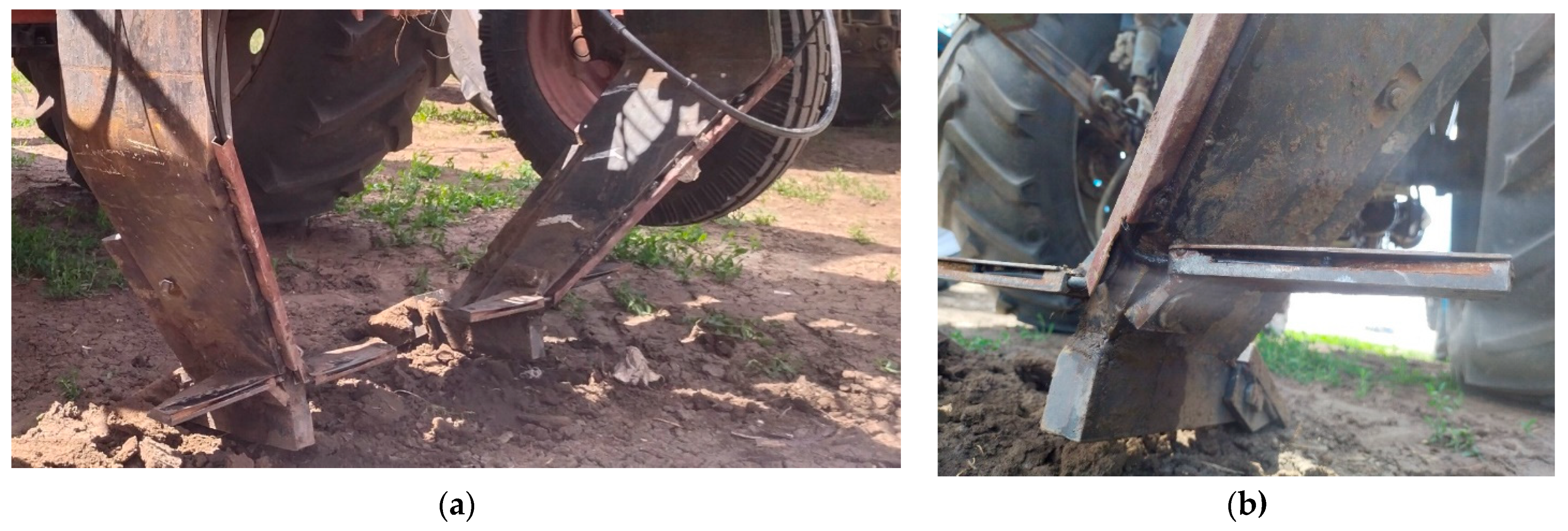
| s | mm | 0 | 0.1 | 0.2 | ||||||||||||
| Vi | m/s | 5 | 6 | 7 | 8 | 9 | 5 | 6 | 7 | 8 | 9 | 5 | 6 | 7 | 8 | 9 |
| Va, km/h | 12 | 73 | 88 | 102 | 117 | 131 | 81 | 97 | 113 | 129 | 145 | 89 | 107 | 124 | 142 | 160 |
| 11 | 80 | 96 | 112 | 127 | 143 | 88 | 106 | 123 | 141 | 158 | 97 | 116 | 136 | 155 | 174 | |
| 10 | 88 | 105 | 123 | 140 | 158 | 97 | 116 | 137 | 155 | 174 | 107 | 128 | 149 | 170 | 192 | |
| 9 | 97 | 117 | 136 | 156 | 175 | 108 | 129 | 151 | 172 | 194 | 118 | 142 | 166 | 189 | 213 | |
| 8 | 110 | 131 | 153 | 175 | 197 | 121 | 145 | 169 | 194 | 218 | 133 | 160 | 186 | 213 | 239 | |
| 7 | 125 | 150 | 175 | 200 | 225 | 138 | 166 | 194 | 221 | 249 | 152 | 182 | 213 | 243 | 273 | |
| 6 | 146 | 175 | 204 | 233 | 262 | 161 | 194 | 226 | 258 | 290 | 177 | 213 | 248 | 283 | 319 | |
| 5 | 175 | 210 | 245 | 280 | 315 | 194 | 232 | 271 | 309 | 348 | 213 | 255 | 298 | 340 | 383 | |
| s | mm | 0 | 0.1 | 0.2 | ||||||||||||
| Vi | m/s | 5 | 6 | 7 | 8 | 9 | 5 | 6 | 7 | 8 | 9 | 5 | 6 | 7 | 8 | 9 |
| Va, km/h | 12 | 85 | 102 | 119 | 136 | 153 | 93 | 112 | 130 | 149 | 167 | 101 | 121 | 141 | 161 | 181 |
| 11 | 93 | 112 | 130 | 149 | 167 | 101 | 122 | 142 | 162 | 182 | 110 | 132 | 154 | 176 | 198 | |
| 10 | 102 | 123 | 143 | 163 | 184 | 112 | 134 | 156 | 178 | 200 | 121 | 145 | 169 | 193 | 218 | |
| 9 | 114 | 136 | 159 | 181 | 204 | 124 | 149 | 173 | 198 | 223 | 134 | 161 | 188 | 215 | 242 | |
| 8 | 128 | 153 | 179 | 204 | 230 | 139 | 167 | 195 | 223 | 250 | 151 | 181 | 211 | 242 | 272 | |
| 7 | 146 | 175 | 204 | 233 | 262 | 159 | 191 | 223 | 254 | 286 | 173 | 207 | 242 | 276 | 311 | |
| 6 | 170 | 204 | 238 | 272 | 306 | 186 | 223 | 260 | 297 | 334 | 201 | 242 | 282 | 322 | 362 | |
| 5 | 204 | 245 | 286 | 326 | 367 | 223 | 267 | 312 | 356 | 400 | 242 | 290 | 338 | 386 | 435 | |
References
- Filcheva, E.; Ilieva, R.; Lubenova, I.; Hristov, B.; Hristova, M. Humus state of Bulgarian chernozems. Modern State of Chernozems. Proc. II Int. Sci. Conf. 2018, 1, 69–76. [Google Scholar]
- Ghazaryan, H.G.; Kroyan, S.; Manukyan, N.; Kalashian, M.Y. Current state of humus in irrigated meadow-brown soils in the Republic of Armenia. Ann. Agrar. Sci. 2016, 14, 307–310. [Google Scholar] [CrossRef]
- Tibbett, M.; Gil-Martínez, M.; Fraser, T.D.; Green, I.D.; Duddigan, S.; De Oliveira, V.H.; Raulund-Rasmussen, K.; Sizmur, T.; Díaz, A. Long-term acidification of pH neutral grasslands affects soil biodiversity, fertility and function in a heathland restoration. Catena 2019, 180, 401–415. [Google Scholar] [CrossRef]
- Nguemezi, C.; Tixier, P.; Yemefack, M.; Tsozué, D.; Silatsa, T. Soil quality and soil fertility status in major soil groups at the Tombel area, South-West Cameroon. Heliyon 2020, 6, e03432. [Google Scholar] [CrossRef] [PubMed]
- Nukeshev, S.; Eskhozhin, D.; Mamyrbayeva, I.; Karaivanov, D.; Gubasheva, A.; Tleumbetov, K.; Kossatbekova, D.; Tanbayev, K. Mathematical Modelling and Designing of a Universal Conical Spreader for Granular Material. Acta Technol. Agric. 2023, 26, 152–158. [Google Scholar] [CrossRef]
- Nukeshev, S.O.; Yeskhozhin, K.D.; Kusainov, R.K. Substantiation of the constructive and technological scheme of the machine for intra soil differentiated three-layer introduction of mineral fertilizers. Int. Sci. J. Mech. Agric. 2016, 3, 3–6. [Google Scholar]
- Altintas, S.; Funda Eryilmaz, A. The effects of mineral and liquid organic fertilizers on some nutritional characteristics of bell pepper. Afr. J. Biotechnol. 2012, 11, 6470–6475. [Google Scholar] [CrossRef]
- Assefa, B.; Chen, Y.; Buckley, K.; Akinremi, W. Effects of manure injection tool type and tool spacing on soil nutrient levels and spring barley performance. Can. Biosyst. Eng./Le Génie Des Biosystèmes Au Can. 2006, 48, 2.45–2.54. [Google Scholar]
- Yuvraj, G.K.; Thakare, S.K.; Deshmukh, M.M. Liquid fertilizer application system on planting mechanism a concept. Natl. Acad. Agric. Sci. 2015, 33, 3789–3791. [Google Scholar]
- Yadav, M.R.; Kumar, R.; Parihar, C.M.; Yadav, R.K.; Jat, S.L.; Ram, H.; Meena, R.K.; Singh, M.B.; Verma, A.P.; Ghoshand, A.; et al. Strategies for improving nitrogen use efficiency: A review. Agric. Rev. 2017, 38, 29–40. [Google Scholar] [CrossRef]
- Cândido de Souza, Á.H.; Lorenzoni, M.Z.; Rezende, R.; Santos, F.A.S.; Seron, C.D.C.; Andrean, A.F.B.A. Fertigation and foliar application with liquid mineral fertilizer doses on lettuce. Sci. Agrar. 2018, 19, 37–43. [Google Scholar]
- Chaorakam, I.; Sukcharoen, A.; Jaiphong, T. Field Evaluation of Subsoiling and Liquid Fertilizer Injection for Minimum Tillage of Sugarcane Planter (Part 1)—Effects of Subsoiling and Liquid Fertilizer Injection on Germination Test. Int. J. Appl. Sci. Technol. 2012, 2, 234–242. [Google Scholar]
- Munroe, J. Soil Fertility Handbook: Vol. Publication 611, 3rd ed.; Ontario Ministry of Agriculture, Food and Rural Affairs (OMAFRA), Ed.; Queen’s Printer for Ontario: Toronto, ON, Canada, 2018. Available online: http://www.omafra.gov.on.ca/english/crops/pub611/pub611.pdf (accessed on 23 November 2021).
- Cieniawska, B.; Parafiniuk, S.; Kluza, P.A.; Otachel, Z. Matching the Liquid Atomization Model to Experimental Data Obtained from Selected Nozzles. Appl. Sci. 2023, 13, 4433. [Google Scholar] [CrossRef]
- Wawrzosek, J.; Parafiniuk, S. The Use of the Permutation Algorithm for Suboptimising the Position of Used Nozzles on the Field Sprayer Boom. Appl. Sci. 2022, 12, 4359. [Google Scholar] [CrossRef]
- Alheidary, M.H.R. Influence of nozzle type, working pressure, and their interaction on droplets quality using knapsack sprayer. Iraqi J. Agric. Sci. 2019, 50, 857–866. [Google Scholar] [CrossRef]
- Makhnenko, I.; Alonzi, E.R.; Fredericks, S.A.; Colby, C.M.; Dutcher, C.S. A review of liquid sheet breakup: Perspectives from agricultural sprays. J. Aerosol Sci. 2021, 157, 105805. [Google Scholar] [CrossRef]
- Kluza, P.A.; Kuna-Broniowska, I.; Parafiniuk, S. Modeling and Prediction of the Uniformity of Spray Liquid Coverage from Flat Fan Spray Nozzles. Sustainability 2019, 11, 6716. [Google Scholar] [CrossRef]
- Nukeshev, S.; Yeskhozhin, K.; Karaivanov, D.; Ramaniuk, M.; Akhmetov, E.; Saktaganov, B.; Tanbayev, K. A Chisel Fertilizer for In-Soil Tree-Layer Differential Application in Precision Farming. Int. J. Technol. 2023, 14, 109–118. [Google Scholar] [CrossRef]
- Chen, Y. A Liquid Manure Injection Tool Adapted to Different Soil Conditions. Trans. ASAE 2002, 45, 1729–1736. [Google Scholar] [CrossRef]
- Tanbayev, K.; Nukeshev, S.; Sugirbay, A. Performance Evaluation of Tillage Knife Discharge Microchannel. Acta Technol. Agric. 2022, 25, 169–175. [Google Scholar] [CrossRef]
- Tanbayev, K.; Nukeshev, S.; Tahsin, E.; Saktaganov, B. Flat Spray Nozzle for Intra-Soil Application of Liquid Mineral Fertilizers. Acta Technol. Agric. 2023, 26, 65–71. [Google Scholar] [CrossRef]
- Majumdar, N.; Tirumkudulu, M.S. Dynamics of radially expanding liquid sheets. Phys. Rev. Lett. 2018, 120, 164501. [Google Scholar] [CrossRef]
- Lightfoot, M. Fundamental classification of atomization processes. At. Sprays 2009, 19, 1065–1104. [Google Scholar] [CrossRef]
- Watson, E.J. The radial spread of a liquid jet over a horizontal plane. J. Fluid Mech. 1964, 20, 481–499. [Google Scholar] [CrossRef]
- Wu, D.; Guillemin, D.; Marshall, A.W. A modeling basis for predicting the initial sprinkler spray. Fire Saf. J. 2007, 42, 283–294. [Google Scholar] [CrossRef]
- Clanet, C.; Villermaux, E. Life of a smooth liquid sheet. J. Fluid Mech. 2002, 462, 307–340. [Google Scholar] [CrossRef]
- Pazhi, D.G.; Galustov, V.S. Fundamentals of the Liquid Atomization Techniques; Chimiya: Moscow, Russia, 1984. (In Russian) [Google Scholar]
- Lechler GmbH. Lechler Agricultural Technology Nozzles. 2017. Available online: https://www.lechler.com/de-en/products-nozzles-spray-technology-systems/product-range/agriculture (accessed on 10 October 2023).
- Fan Nozzle. BETE Spray Nozzles. 2023. BETE Spray Technology. Available online: https://bete.com/pattern/fan-spray-pattern (accessed on 10 October 2023).
- Azuma, T.; Hoshino, T. The radial flow of a thin liquid film: 2nd report, liquid film thickness. Bull. JSME 1984, 27, 2747–2754. [Google Scholar] [CrossRef]
- Azuma, T.; Hoshino, T. The radial flow of a thin liquid film: 3rd report, velocity profile. Bull. JSME 1984, 27, 2755–2762. [Google Scholar] [CrossRef]
- Tanbayev, K.; Nukeshev, S.O.; Tahsin, E. Determination the cavity shape and sizes on the trail of the tillage knife for liquid fertilizer application. Sci. J. Bull. Sci. S. Seifullin Kazakh Agro Tech. Res. Univ. 2023, 2, 99–108. (In Kazakh) [Google Scholar]
- Zaree, M.; Parashkoohi, M.G.; Ghafori, H.; Zamani, D.M. Investigation of flow pattern in an innovative nozzle: An experimental 655 and numerical study in agricultural systems. J. Saudi Soc. Agric. Sci. 2023. [Google Scholar] [CrossRef]
- Becze, S.; Vuşcan, G.I. Comparison study between two types of nozzles for a turbocharger balancing machine using ANSYS software. MATEC Web Conf. 2019, 299, 04007. [Google Scholar] [CrossRef]
- Wang, J.; Liang, Q.; Zeng, T.; Zhang, X.; Wei, F.; Lan, Y. Drift Potential Characteristics of a flat fan nozzle: A Numerical and Experimental study. Appl. Sci. 2022, 12, 6092. [Google Scholar] [CrossRef]
- Sanjai, P.R. Jet Impingement on a Flat Plate with Different Plate Parameters. Int. J. Res. Eng. Sci. Manag. 2018, 1, 49–51. [Google Scholar]
- Sagot, B.; Antonini, G.; Christgen, A.; Buron, F. Jet impingement heat transfer on a flat plate at a constant wall temperature. Int. J. Therm. Sci. 2008, 47, 1610–1619. [Google Scholar] [CrossRef]
- Aabid, A.; Khan, S.A. Investigation of high-speed flow control from CD nozzle using design of experiments and CFD methods. Arab. J. Sci. Eng. 2021, 46, 2201–2230. [Google Scholar] [CrossRef]
- Kenzhegulova, S.O. Soil Science; Printing house of KazATU: Astana, Kazakhstan, 2016; 106p. (In Kazakh) [Google Scholar]
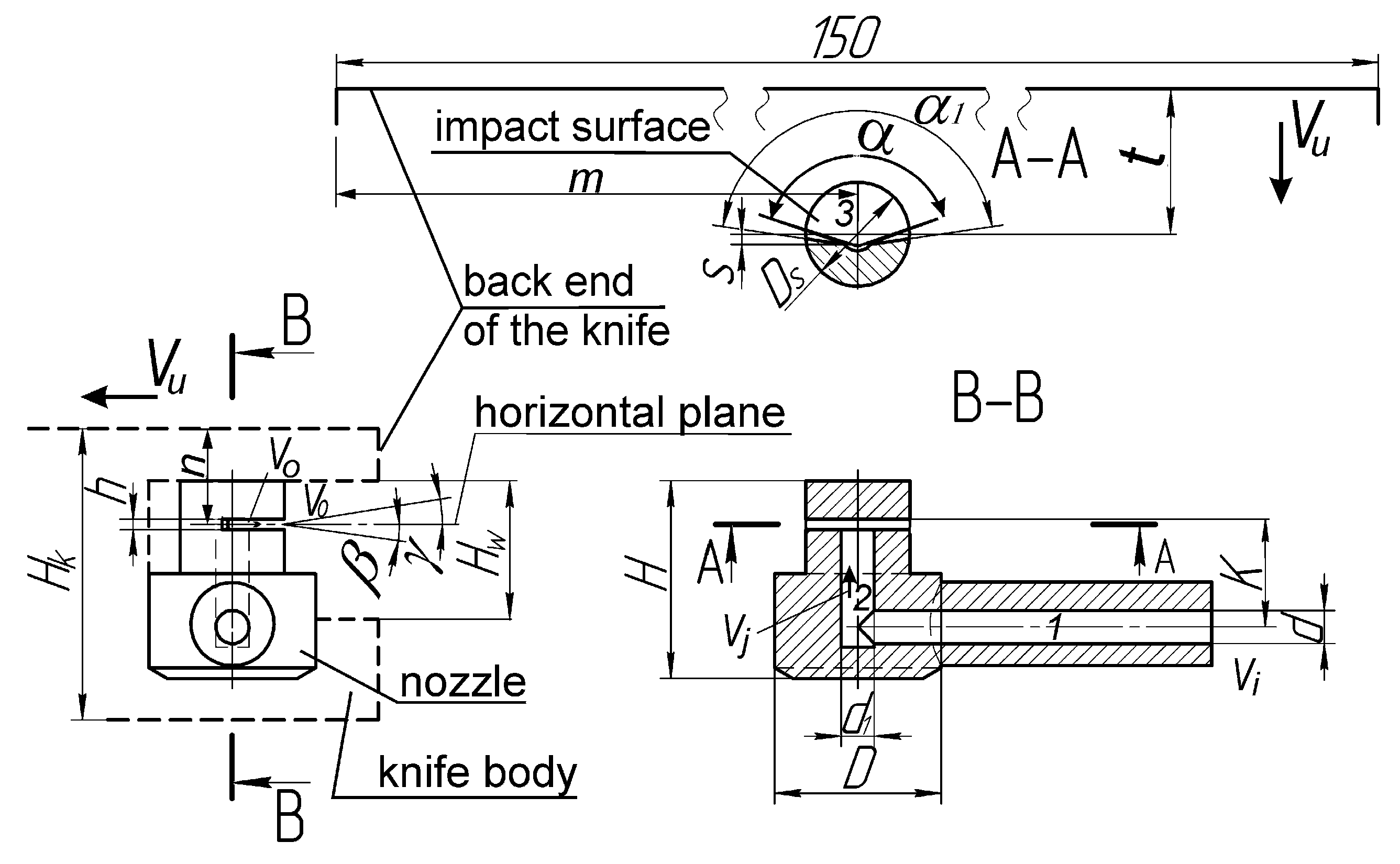
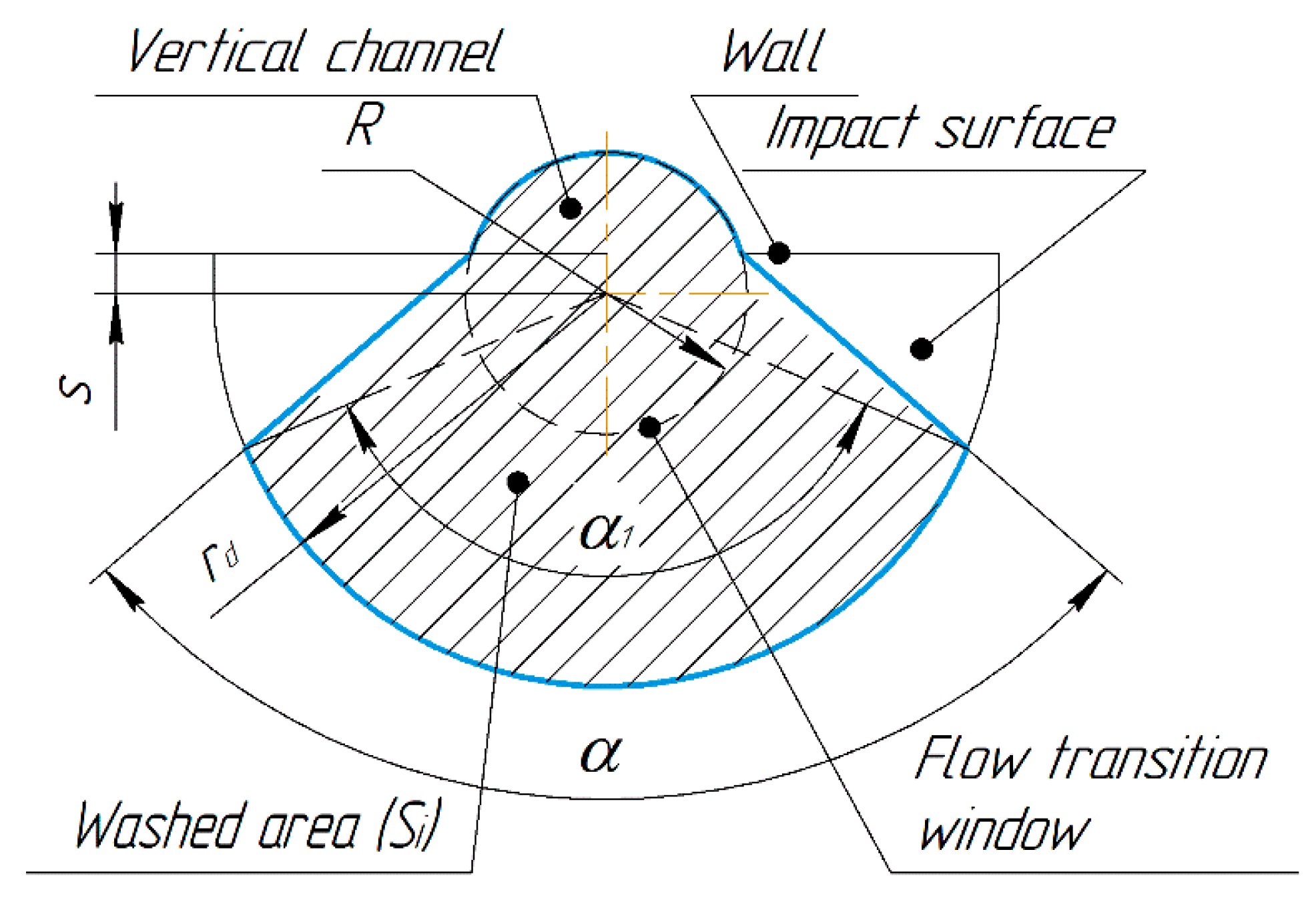
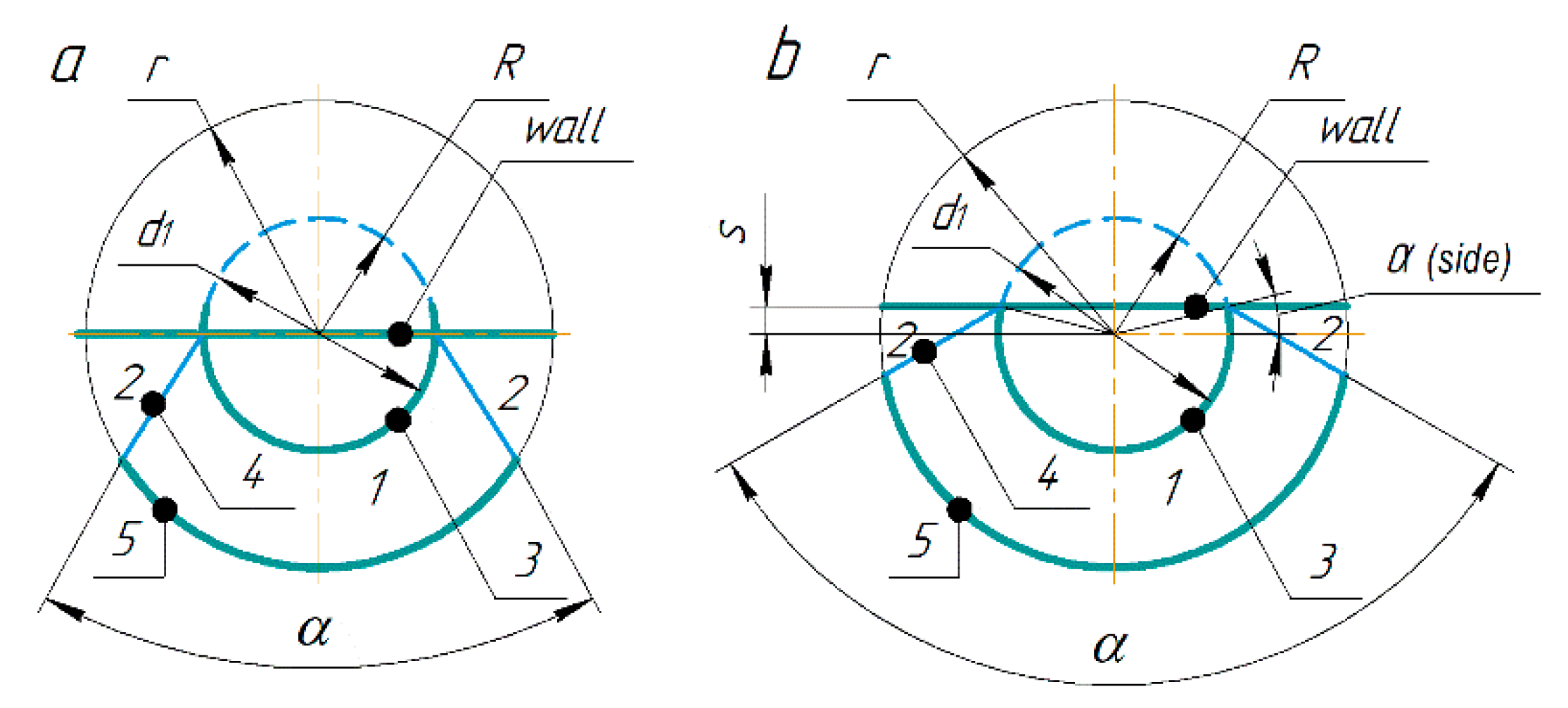
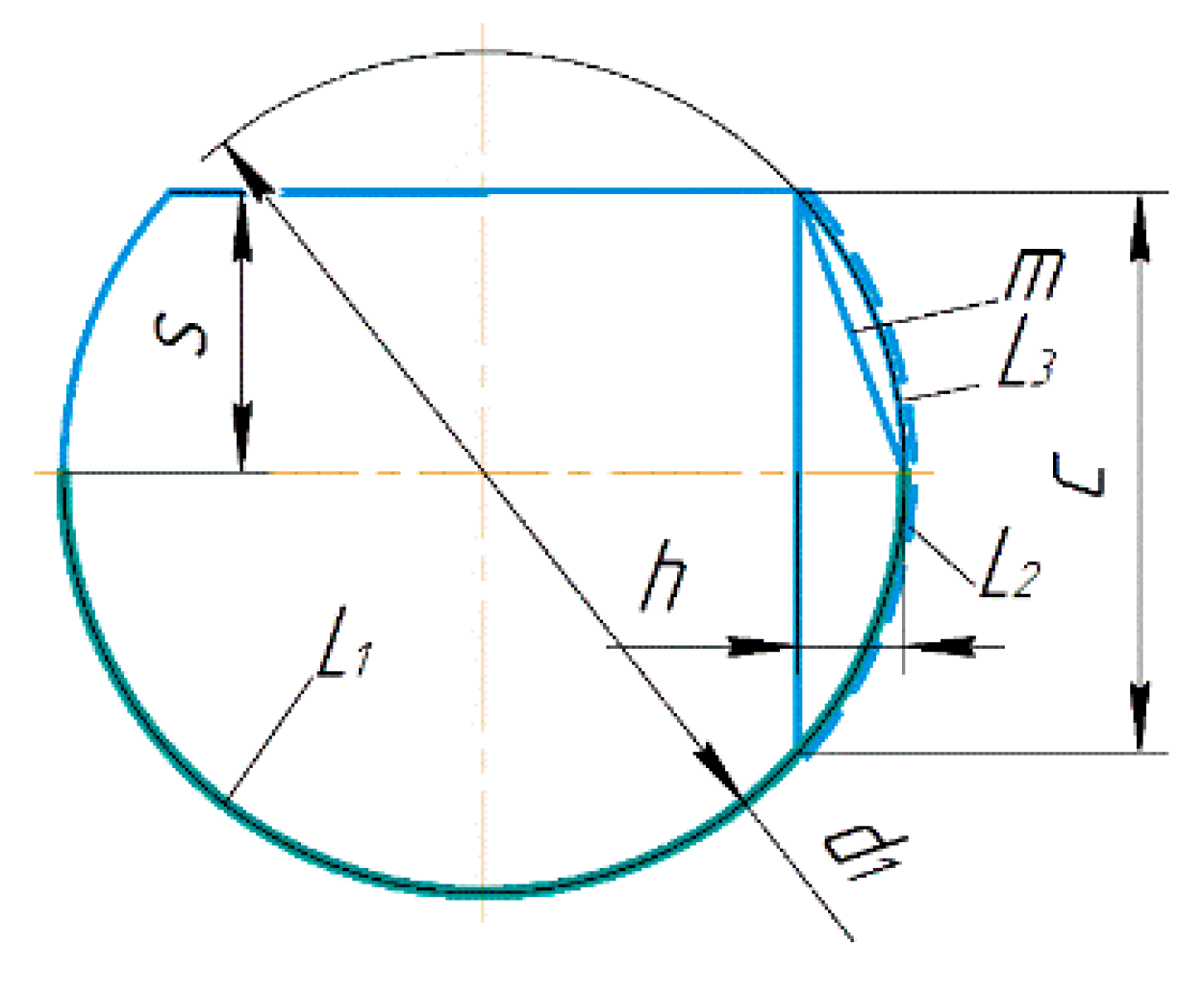


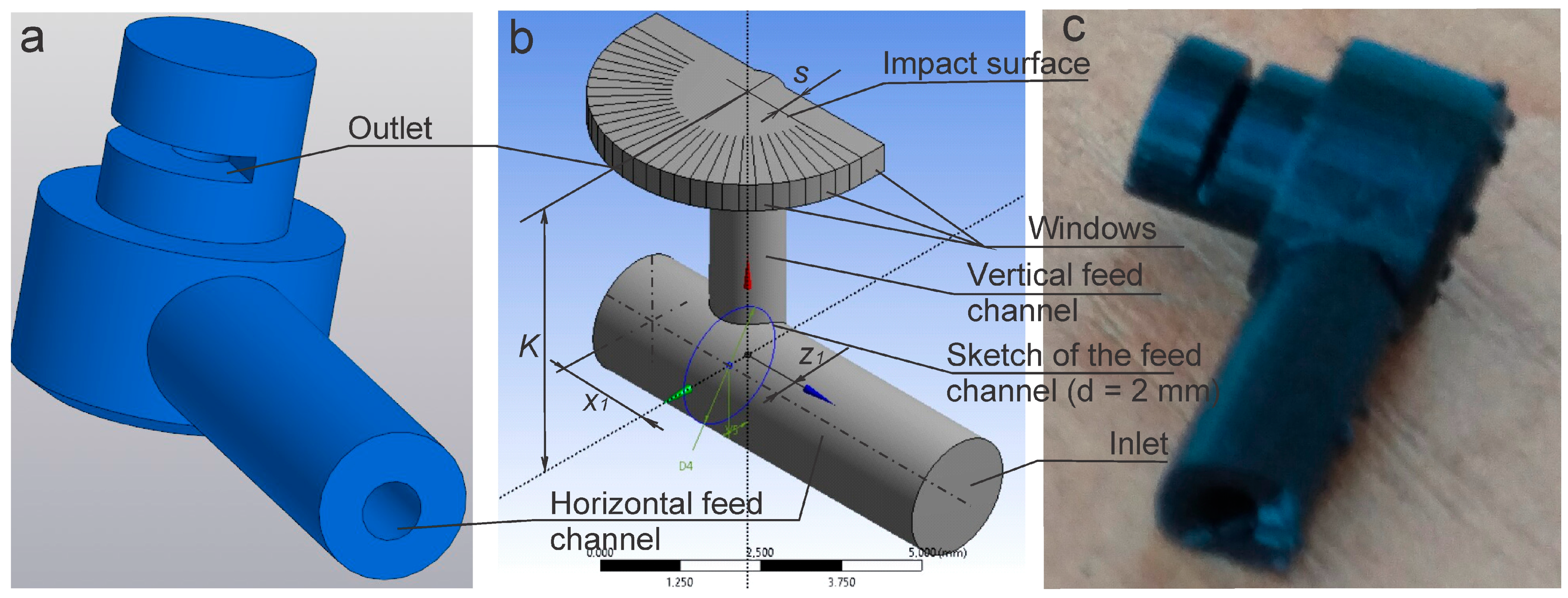
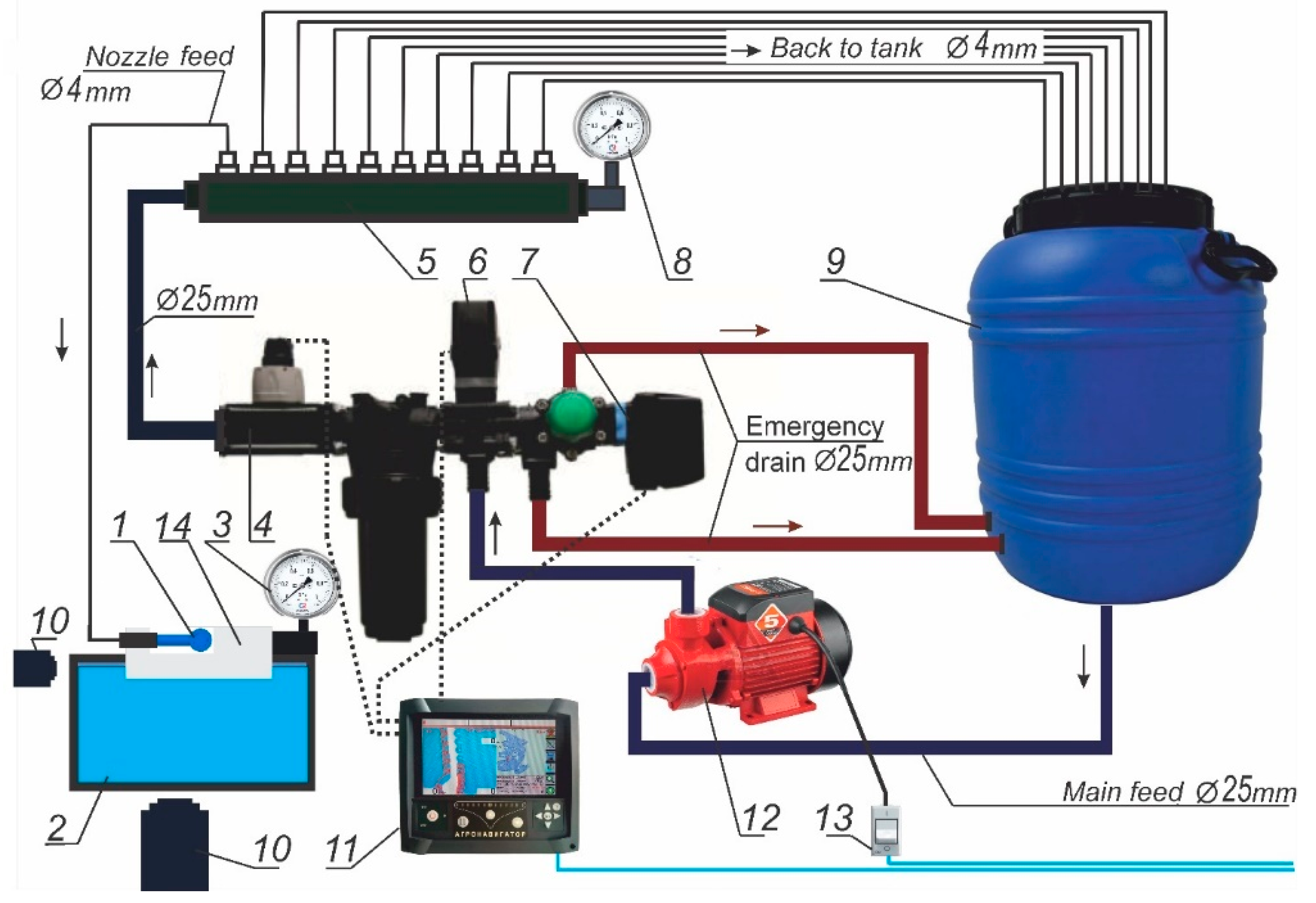
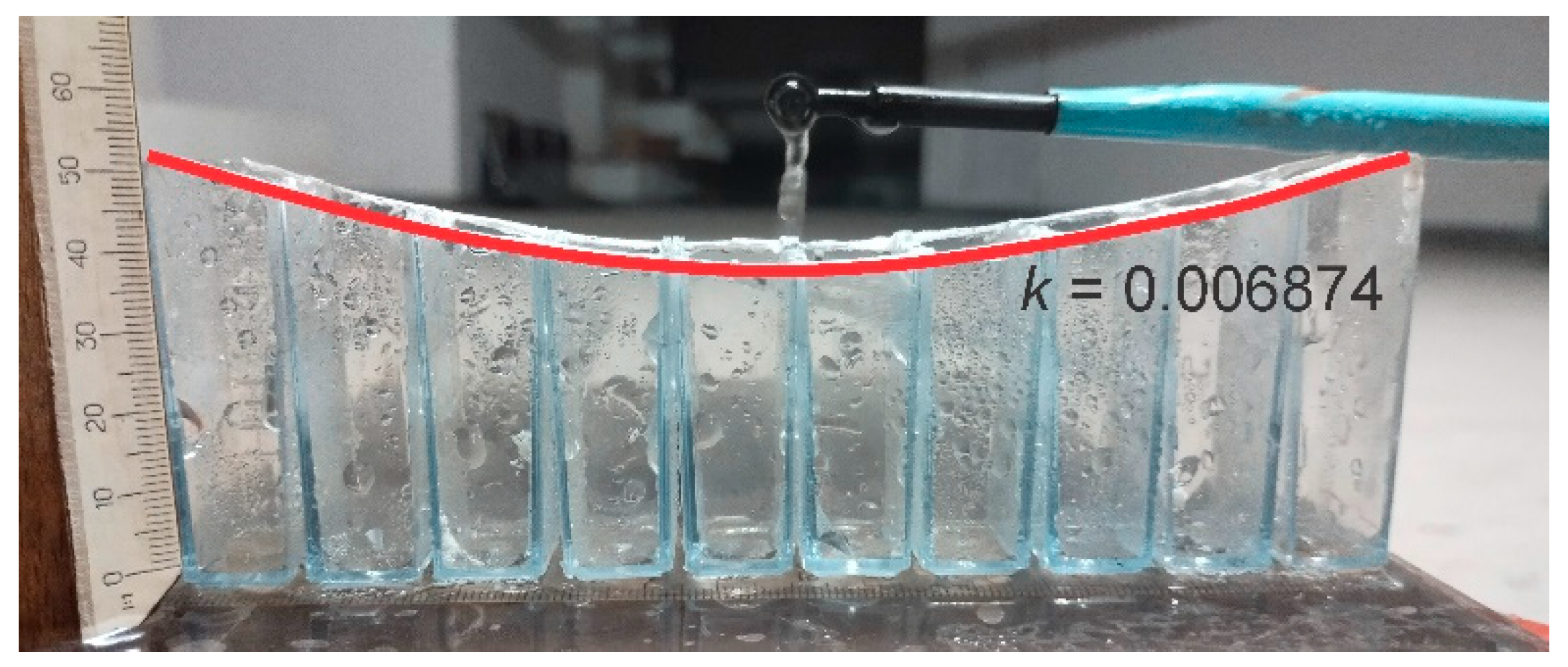
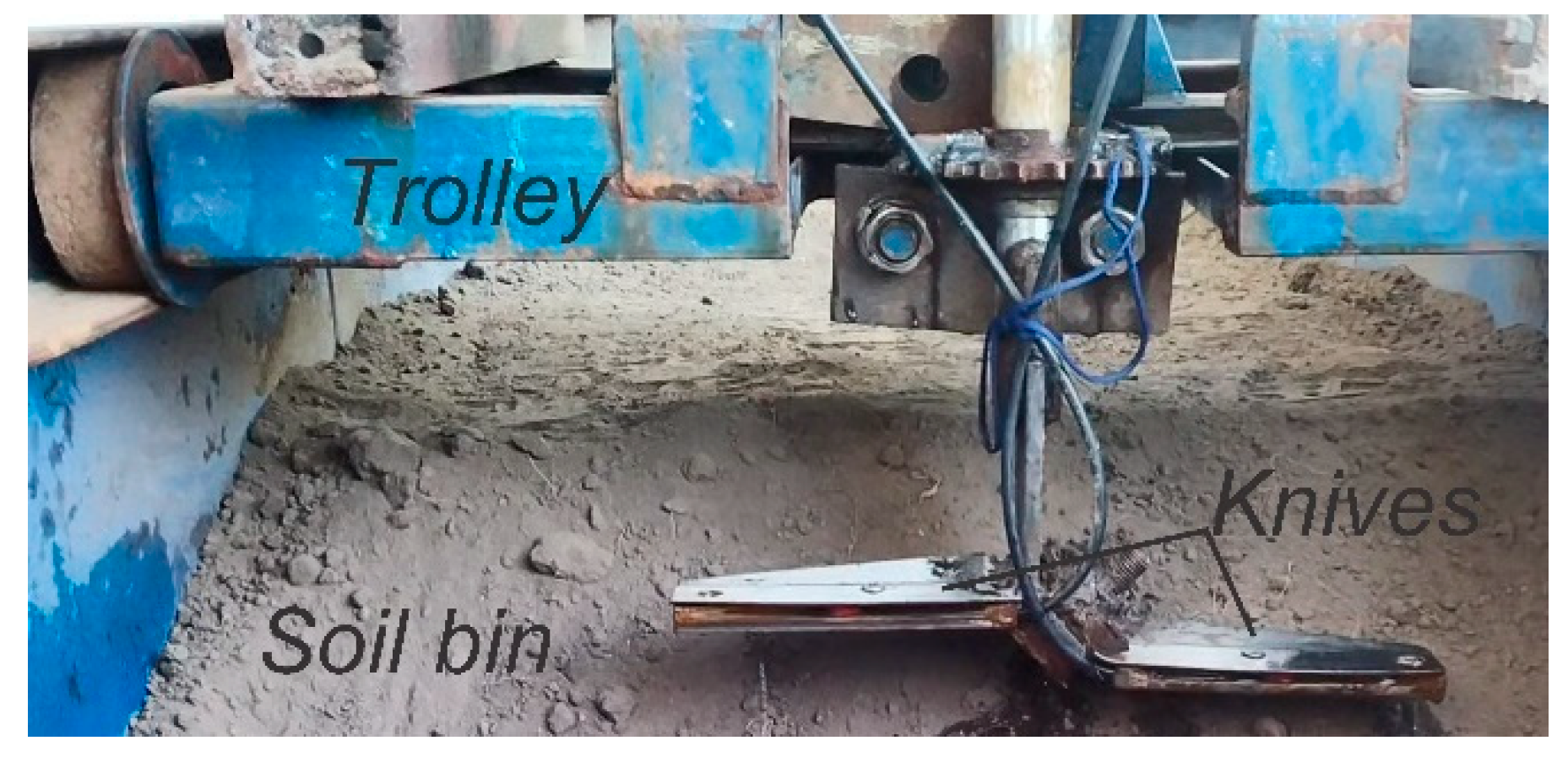
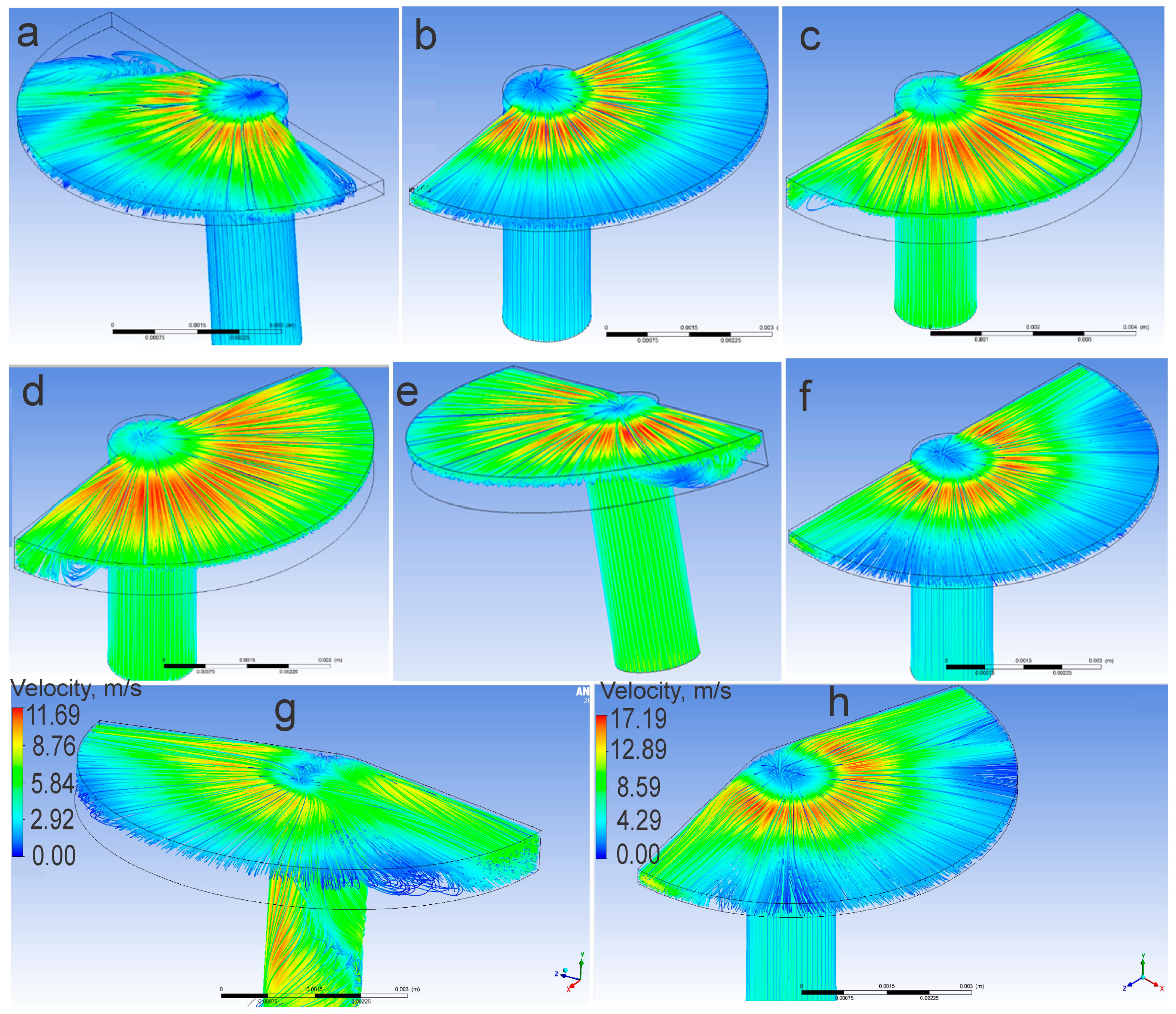

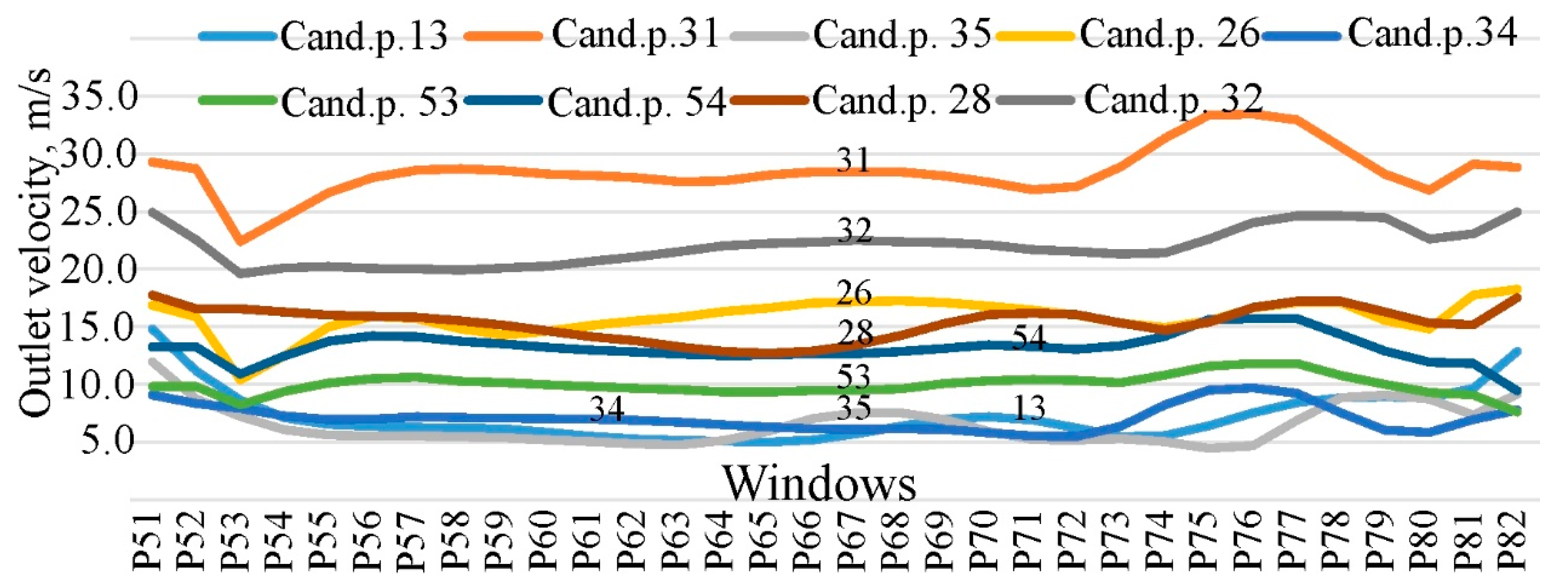

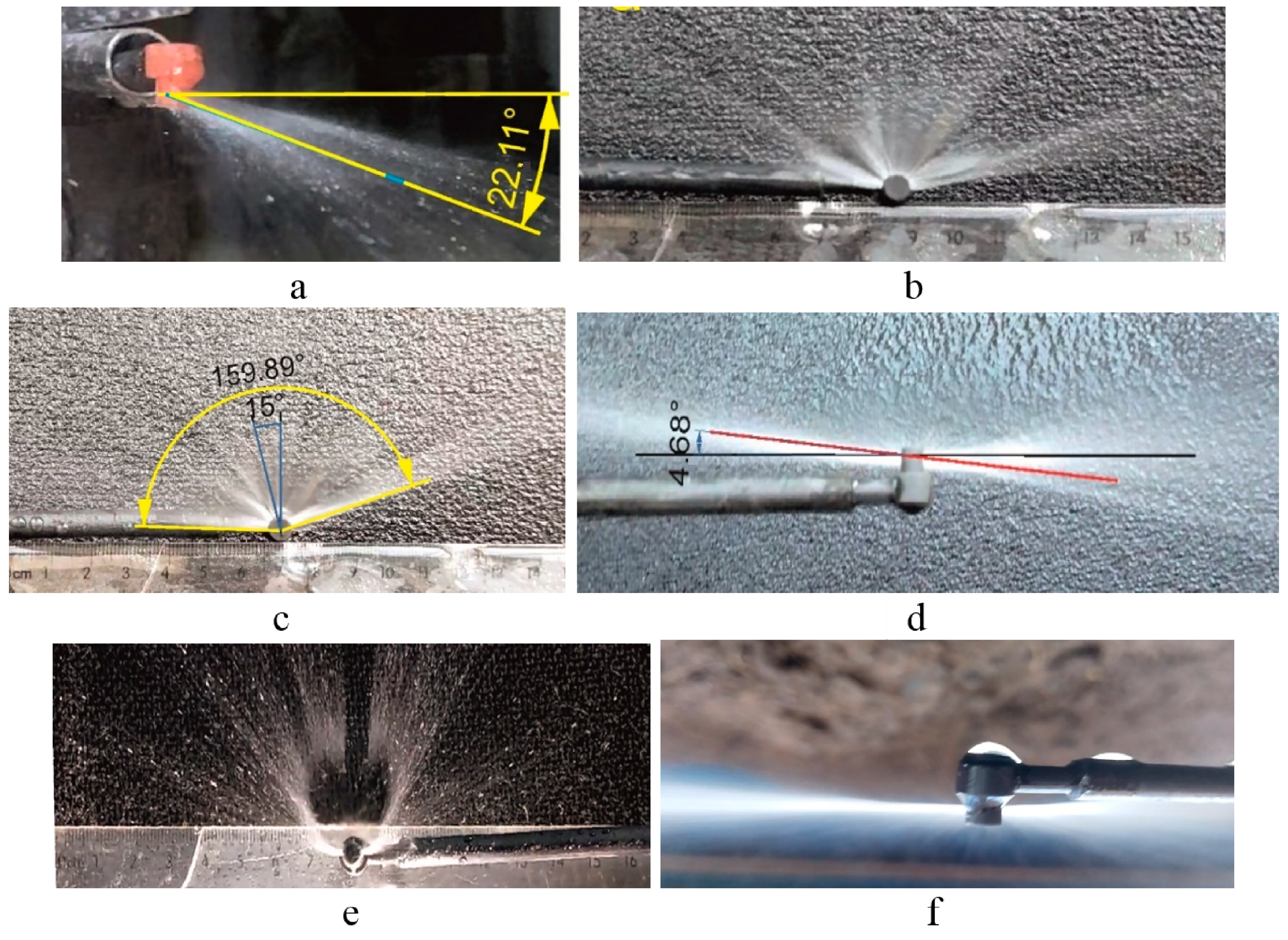
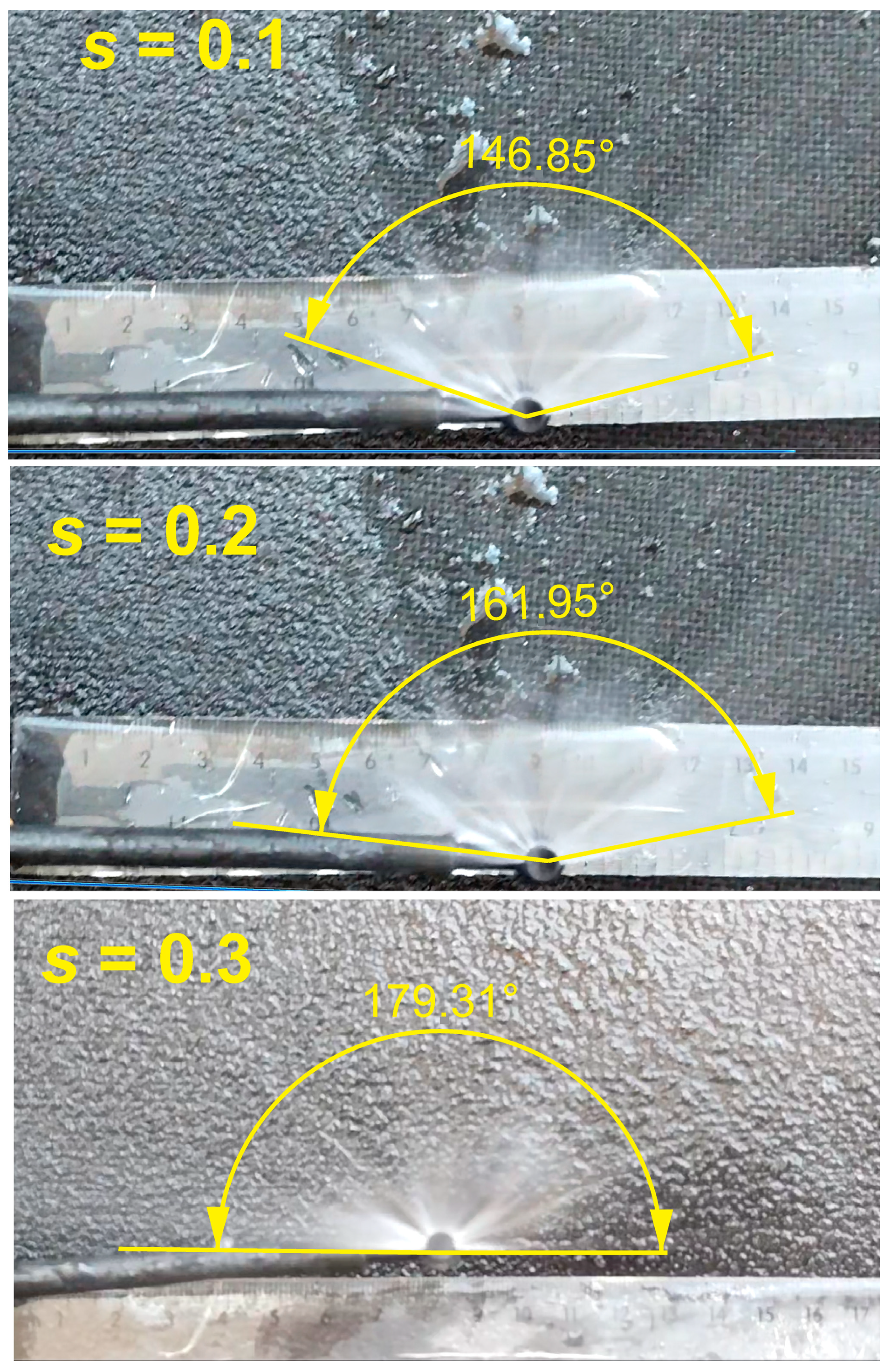


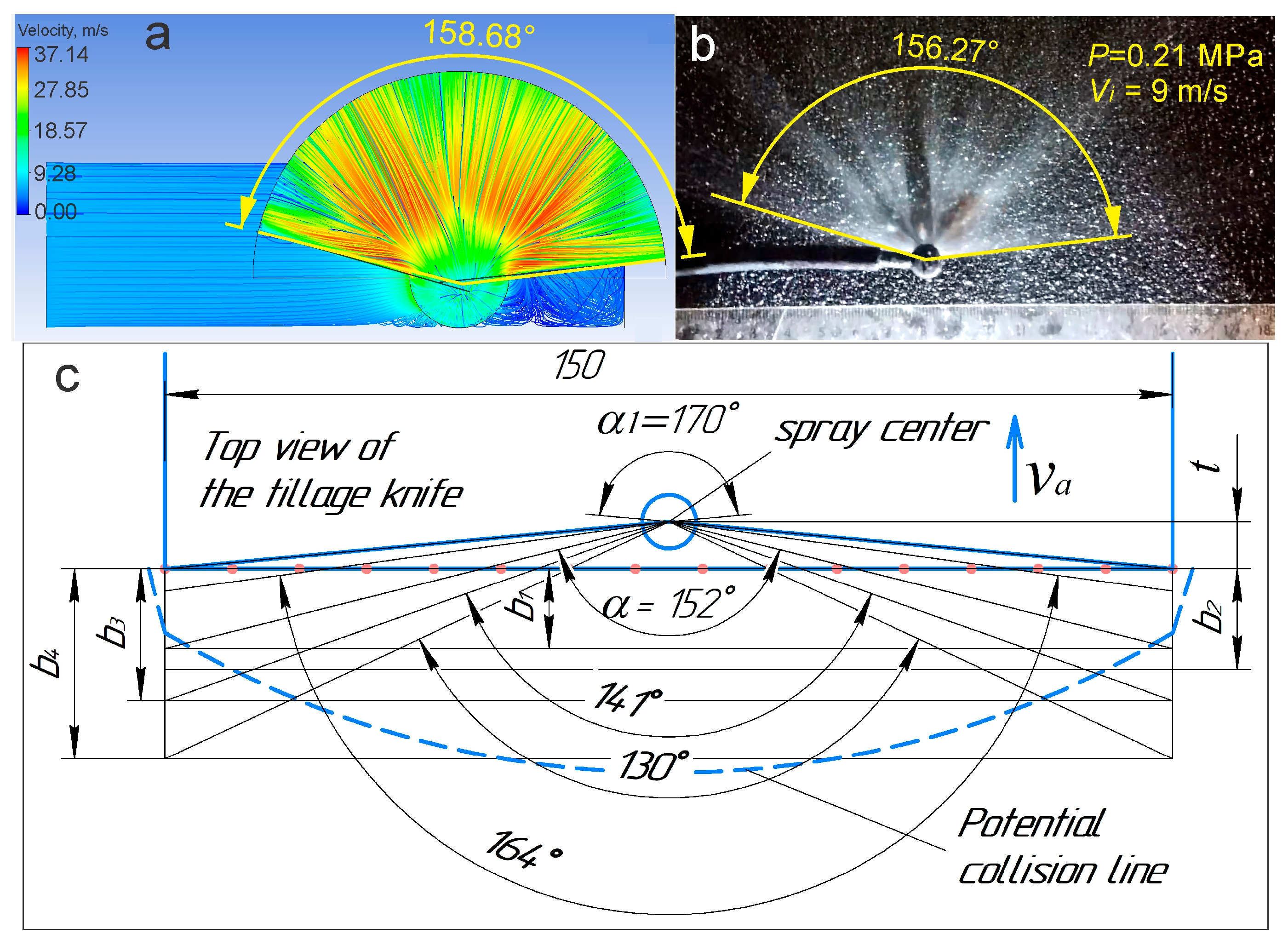
| Name of Parameters | Extrude4.FD1, (h) mm | ZXPlane.R5, (R) mm | Plane4.R16, (rd) mm | Velocity, Vi, mm/s | |
|---|---|---|---|---|---|
| Settings code | P2 | P3 | P74 | P154 | |
| Manufacturable parameter options | 1-option | 0.3 | 0.5 | 2.5 | 5000 |
| 2-option | 0.4 | 0.6 | 3 | 6000 | |
| 3-option | 0.5 | 0.7 | 3.5 | 7000 | |
| 4-option | 0.6 | 0.8 | 4 | 8000 | |
| 5-option | 0.7 | 0.9 | 4.5 | ||
| 6-option | 0.8 | 1 | |||
| Variants | P2—Extrude4.FD1 (mm) | P3—ZXPlane.R5 (mm) | P6—YZPlane.V5 (mm) | P7—Plane4.L18 (mm) | P8—Extrude12.FD4 (mm) | P9—Velocity (mm/s) | P110—Eq2-op | P111—Eq1-op | P112—End Ratio |
|---|---|---|---|---|---|---|---|---|---|
| K | R | z1 | s | x1 | Vi | U | |||
| 31 | 0.5 | 0.6 | 0.1 | 0.1 | 1.4 | 8000 | 1.023674 | 0.758 | 0.74113 |
| 28 | 0.5 | 0.8 | 0.1 | 0.3 | 2 | 6000 | 1.153323 | 0.683 | 0.59225 |
| Pressure, MPa | Flow Rate, L/s | Spray Angle at z1 = 0 | hd |
|---|---|---|---|
| 155° | |||
| 0.18 | 0.010125 | 146° | |
| 0.15 | 0.00975 | 142° | 0.144289 |
| 0.13 | 0.008625 | 136° | 0.144289 |
| 0.11 | 0.008 | 130° | 0.144289 |
| 0.095 | 0.0075 | 125° | |
| 0.08 | 0.007 | 124° | |
| 0.078 | 0.0065 | 118° | |
| 0.065 | 0.006 |
| Tests | Amount of Fluid in Cells (Left to Right), mL | Average Value (Qo), mL | Coefficient of Variation, Vσ | Uniformity (Adjusted Value), Uc | |||||||||
|---|---|---|---|---|---|---|---|---|---|---|---|---|---|
| 1 | 2 | 3 | 4 | 5 | 6 | 7 | 8 | 9 | 10 | ||||
| 1 | 3 | 4 | 4 | 4 | 4,5 | 4 | 4 | 3.5 | 4 | 2 | 3.7 | 10.11% | 0.77 |
| 2 | 3 | 4 | 4 | 3 | 4 | 3 | 3 | 4 | 4 | 3.5 | 3.55 | 14.01% | 0.79 |
| 3 | 3 | 5 | 4 | 4 | 4 | 4.5 | 3 | 3.5 | 4 | 5 | 4 | 17.68% | 0.75 |
| 4 | 3 | 5 | 4 | 4 | 5 | 4.5 | 2 | 4.5 | 4 | 3 | 3.9 | 24.77% | 0.68 |
| 5 | 3 | 5 | 4 | 4 | 4.5 | 4 | 4 | 3.5 | 4 | 2 | 3.8 | 21.67% | 0.67 |
| 6 | 2.2 | 2.2 | 6 | 5 | 4 | 4 | 4 | 5 | 4 | 4 | 4.04 | 29.13% | 0.65 |
| 7 | 3 | 4 | 4 | 5 | 4 | 4 | 4 | 5 | 5 | 4 | 4.2 | 15.06% | 0.76 |
| 8 | 2.2 | 2.2 | 4 | 5 | 4 | 4 | 4 | 5 | 4 | 4 | 3.84 | 24.89% | 0.68 |
| 9 | 4 | 3 | 4 | 4 | 6 | 6 | 5 | 4 | 4 | 4 | 4.4 | 21.96% | 0.72 |
| 10 | 4 | 4 | 4 | 4 | 5 | 5 | 5 | 4 | 4 | 3 | 4.2 | 15.06% | 0.76 |
| Average | 0.72 | ||||||||||||
Disclaimer/Publisher’s Note: The statements, opinions and data contained in all publications are solely those of the individual author(s) and contributor(s) and not of MDPI and/or the editor(s). MDPI and/or the editor(s) disclaim responsibility for any injury to people or property resulting from any ideas, methods, instructions or products referred to in the content. |
© 2024 by the authors. Licensee MDPI, Basel, Switzerland. This article is an open access article distributed under the terms and conditions of the Creative Commons Attribution (CC BY) license (https://creativecommons.org/licenses/by/4.0/).
Share and Cite
Nukeshev, S.; Tanbayev, K.; Ramaniuk, M.; Kakabayev, N.; Sugirbay, A.; Moldazhanov, A. Spray Angle and Uniformity of the Flat Fan Nozzle of Deep Loosener Fertilizer for Intra-Soil Application of Fertilizers. AgriEngineering 2024, 6, 1365-1394. https://doi.org/10.3390/agriengineering6020079
Nukeshev S, Tanbayev K, Ramaniuk M, Kakabayev N, Sugirbay A, Moldazhanov A. Spray Angle and Uniformity of the Flat Fan Nozzle of Deep Loosener Fertilizer for Intra-Soil Application of Fertilizers. AgriEngineering. 2024; 6(2):1365-1394. https://doi.org/10.3390/agriengineering6020079
Chicago/Turabian StyleNukeshev, Sayakhat, Khozhakeldi Tanbayev, Mikalai Ramaniuk, Nurbol Kakabayev, Adilet Sugirbay, and Aidar Moldazhanov. 2024. "Spray Angle and Uniformity of the Flat Fan Nozzle of Deep Loosener Fertilizer for Intra-Soil Application of Fertilizers" AgriEngineering 6, no. 2: 1365-1394. https://doi.org/10.3390/agriengineering6020079









